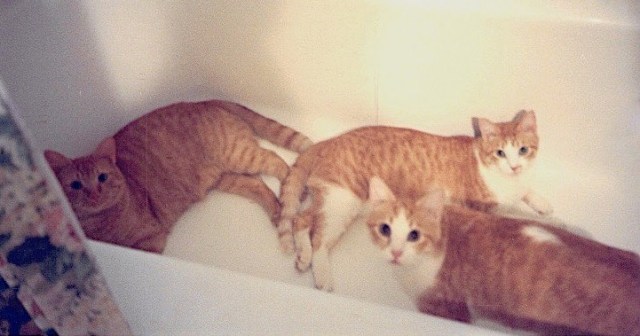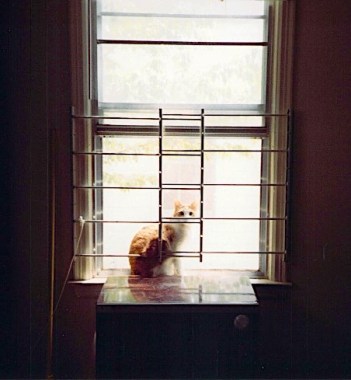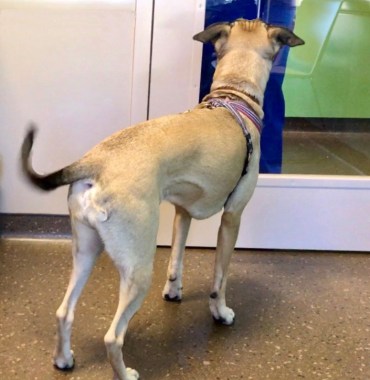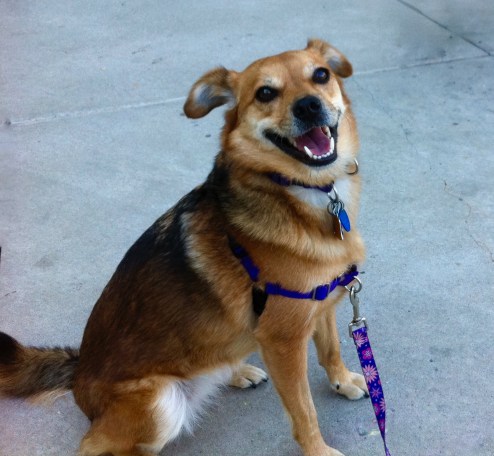Barks Blog
The Last Trip To the Vet: What If Your Pet’s Last Breath Is on the Operating Table?
Alex in the foreground, with Rusty and Andrew behind him—photo from 1993. Yes, they are in a bathtub.
Many years ago I lost Alexander, my dear, dear cat to stomach cancer. This was before veterinary medicine had the technology that’s available today. It was also before I took as proactive an approach to my animals’ health and welfare needs as I do now. I knew nothing about training or socialization. My cats were not crate- or carrier-trained. I didn’t know to use counterconditioning, desensitization, and habituation to teach them that the vet’s office could be a great place (or at least not an awful one). As a result, it was a struggle to take my cats to the vet and most were terrified there.
This came to a head with Alex. He had had a rough start in life. He was a runt of a neighborhood litter, rejected by his mother, and he almost died of parasites. My friend and I bottle fed him and nursed him to health. He was a difficult cat for many years but we bonded very closely.
When he was eight years old, he started losing weight. I took him to the vet, who did blood work and could not identify a problem. He gave me pills to induce Alex to eat, something I now regret with some horror. It was an exhausting battle for both of us when I tried to get the pills down him. And after he did eat, digesting food probably caused him pain. After a few months, as Alex lost more and more weight, the vet thought he felt nodules in Alex’s abdomen. This was before ultrasound equipment was commonly available at vet practices, or at least at this one, so this was through palpation only. The vet thought he had localized kidney cancer and was hopeful that he could surgically remove it.
I remember, vividly and painfully, taking Alex to the vet for this surgery. He was petrified. I was required to take him at 8 AM. Then I left and waited and waited for a phone call. They didn’t operate until after noon. When the vet performed the surgery, he found that Alex was riddled with cancer. He called me and we agreed that there was no option but to euthanize Alex then and there. I was still in shock that I was losing this comparatively young cat, but another thing that I can still barely stand to think about was that he was terrified, in a steel cage in an unfamiliar place, for the last four hours of his life.
Things Have Improved
It is much more common now for people to work with their animals so that they won’t be scared of novel situations, handling, or the vet’s office. More and more people are learning husbandry techniques. There is now Fear Free Certification for veterinary professionals and trainers. And even many practices that don’t have the certification are practicing more techniques to keep the animals truly calm, rather than shut down.
There are countless things to prepare our dear pets for, with the goal of making these activities minimally stressful. One thing that many of our pets will eventually face is euthanasia. And when the time comes, we humans are not likely to be at our best.
I have a wonderful and brave friend who includes “euthanasia games” in her husbandry work with her dog. Getting her belly shaved, getting prepared for an injection or an IV insertion—all those steps we humans absolutely dread for our animals—can be predictors of great food and fun for a beloved pet. Just another game to her. And even if, at the end, the dog can’t or won’t take food, the activities will at least be familiar and have good associations.
In addition to this type of preparation, there are more and more options for at-home euthanasia, which is almost always less stressful.
Because of these factors, the odds of our pets’ end of life being low stress and pain-free have greatly improved. But there is one situation that is hard to prepare our animals for, and almost impossible to prepare ourselves for. That is if our pet must be euthanized on the operating table and have to undergo the waiting and prep for surgery without us. This may be during a routine surgery that turns up something awful and unexpected. It could be in the event of exploratory surgery, where something awful is expected. Or it could happen because of an unplanned emergency. I have been through the exploratory surgery situation with two beloved animals now.
Summer
My dog Summer was euthanized in August 2017 on the operating table after exploratory surgery unveiled hopelessly advanced hemangiosarcoma. The vet and I had agreed to this plan beforehand. We would not revive Summer if the cancer were too advanced. (Some people make different choices about this. This is a deeply personal decision, and I respect all approaches.) The vet performed the surgery because of some hopeful signs on the ultrasound. But Summer had widespread cancer metastases.
Summer, just like Alex, spent her last waking hours waiting, without me, in a cage. I hope it was different for her because of the preparation I did do. I am thankful that every time I took Summer to the vet, I took her mat and some treats (unless she was fasting). I worked at making vet visits pleasant, with good associations. Some vets gave her treats, too. I did not do this methodically, though, and I wish I had. The vet I took her to most often was a large practice in a cramped space, and often fully booked, so we never went for practice or play visits.
Summer did have a few experiences of staying at the vet for a length of time. She had been spayed immediately after I adopted her, and also at age five she had had a bout of hemorrhagic gastroenteritis, a life-threatening problem. She was hospitalized for several days. I treasure the video I took of her emerging when I came to get her to take her home.
[youtube https://www.youtube.com/watch?v=tOfLYj4VANc?feature=oembed]
I mention these experiences because they were times when I left her at the vet and she had to stay there for medical procedures and be kenneled and then I came and got her again. I hope that in her doggie brain, staying in a cage at the vet was enough of a familiar routine with a good outcome. But I wish I could have prepared her much more.
Leaving a Pet at the Vet: Can We Practice?
If my experience with my pets’ veterinary care is typical, some vets have a surgery list for their surgery day, but the order of surgeries can be fluid. I have always been asked to have my pet there fairly early in the morning, even if they end up having their surgery several hours later. I have not had the option of waiting with them, but I hope to have that option if there is a next time for this.
Perhaps some of you have a close enough relationship with your vet to be able to stay with your dog or cat as they wait for surgery. Or perhaps your vet schedules surgeries so your pet doesn’t have to be in limbo in a back room for long. I have not had those options. And I don’t think many of us can count on always having those options since we never know when we might have a medical emergency with our pet and end up seeing an ER vet we don’t know.
So after going through this exploratory surgery nightmare twice, it occurred to me that the animal waiting alone is just another husbandry task. As much negativity as there is about “sending our animals to the back room at the vet,” there always may be some times when they have to be without us for medical care. Can we prepare them for that?
Here are some ideas about getting your animal used to being handled without you being there. This presupposes that you trust your vet.
- Go to a Fear-Free Certified veterinary practice. They will know techniques to help calm your pet and will be on board for any efforts you want to make to make things better for the animal. If you don’t have one locally, promote the program to the local veterinarians.
- If the vet boards animals, and it’s affordable, pay for boarding every once in a while but do it for a very short period at first. Depending on the dog, this might mean starting at 5 minutes. Assume you will be paying for a day. Remember, it’s still work for vet staff to take your dog back to a kennel, load her in, and get her out for you, and you are reserving a space that could have accommodated another animal. If the practice offers a discount or lets you do it for free on a slow day, so much the better. But don’t expect or demand it.
-
If your dog is doing OK with the short “boarding” visits, take the option of dropping her off at the vet for them to work her in for an innocuous procedure—something they have done before and you have practiced with her. Anal check, ear check, an inoculation. I know, I know. I NEVER used to take the “drop them off and we’ll work her in” option. I hated the idea precisely because I didn’t want to leave my dogs in a noisy cage among strangers. But with some preparation, wouldn’t doing that every once in a while with a vet you trust be better than their first experience being when they are very ill and you may never see them again? Food for thought.
- Stating the obvious, but crate train the dog. Get her used to all different kinds of crates, and take her and crate her in all different situations. Work up to noisy situations with dogs barking. Agility trials are good for this, but remember: that’s graduate school work. Your dog needs to be completely comfortable in a crate in general and in other challenging situations first. I always think of vet scenarios when people talk about not needing to crate train their dogs. You may be able to arrange your life at home so that you never crate your dog. But…what about at the vet? From here on I will train any animal I have to be calm about confinement.
- Ask your vet if there is a sedative that would be safe for your dog to take before surgery or other procedures. I talked to a veterinarian friend before making this suggestion. She said it could be an option in many cases. You may have to try it ahead of time to make sure it works as intended on your pet. Your vet can counsel you about this. I did this with two dogs: Cricket, and Clara, “practicing” under my vet’s instruction ahead of time with a sedative before they were to have a medical procedure. In Cricket’s case, the drug had a paradoxical effect, making her hyper and drunkenly wobbling all around. So we didn’t use it. In Clara’s case, the sedative had a calming effect, and she had some before she went in for a large set of X-rays.
As a result of my experience with Summer (and dear Alex, all those years ago), I have started to take my dogs to the vet to get their anal glands expressed without me present. I did it for a blood draw once as well. I want them to learn that yes, sometimes they have to go with someone else and perhaps have something a bit unpleasant done, but then they will come back to me. I wait for them in the waiting room with the best goodie possible. Even though I trust my vet to treat my dogs humanely, carefully, and as fear-free as possible, I pay attention to the results. If the dogs are getting more sensitized, more afraid from these experiences, they aren’t helping. Time to back up and do some less intense work at the vet as we are able.
I am going to do everything I can to be sure that my current and future animals are not terrified if they have to wait in a kennel for surgery. We don’t know if our dogs can think ahead in the way we do. But we do know that they learn that certain events predict others. It’s the basis of classical conditioning. And I want my dogs to know that a stay in the “back room” at the vet will be followed by returning to me and getting love. In this world or in my heart.
Related Posts
Both of these are on my dog dementia site.
Copyright 2018 Eileen Anderson
Thank you to my veterinarian friend with whom I discussed parts of this post.




